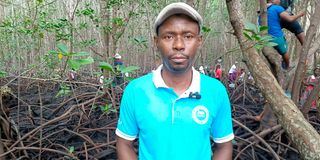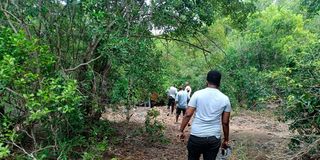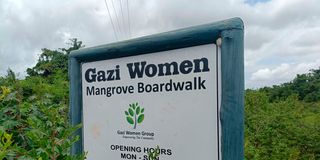Coastal communities cash in on carbon credits as others cry foul

Mr Hamisi Ali, a lab technologist at Kenya Marine and Fisheries Research Institute, prepares to measure carbon capture potential of mangrove trees in Gazi Bay, Kwale.
What you need to know:
- Mau is a source of several rivers that feed many lakes in Kenya and neighbouring countries.
It’s 10am when we arrive in Gazi Bay, which is located in South Coast, Kwale County.
The roads that meander into the tiny village are all neatly done with concrete paving blocks commonly known as cabro. This is despite the area being covered by dilapidated makuti housing structures, where most locals live.
“The roads you are admiring would not have been built were it not for the ‘Mikoko Pamoja’ carbon credits initiative,” our taxi driver breaks the pin drop silence that had filled the air almost the entire journey.

A field assistant touring the Mikoko Pamoja mangrove project in Gazi Bay, Kwale County.
He, however, admits that he is not completely sure what carbon credits are although he knows it involves planting and taking care of mangrove trees in the area in exchange for monetary reward from international parties. The money goes into financing community-chosen projects.
“The latest project has provided residents of Gazi and Makongeni with clean piped water. As a community, we no longer rely on piped water from the county government because it is so expensive,” the taxi driver highlights.
Outside Mikoko Pamoja offices, we meet Mr Nema Pasua, who has been waiting patiently to show us around.
“I am a field assistant at Kenya Marine Service and we are involved in the project,” he says.
He explains that the project is a small-scale carbon offset facility that aims at conserving mangroves through the sale of carbon credits.
It seeks to provide long-term incentives for mangrove restoration and protection through community engagement and participation.
“This is achieved through conservation activities, awareness creation and the sale of mangrove carbon credits. Revenue generated (US$24,000/annum — Sh3 million) from sale of carbon credits is used to support local development projects in water and sanitation, education, health and environment conservation.
“Mikoko Pamoja is an excellent example of a ‘triple win’ project for climate, community and biodiversity conservation,” the field assistant explains as he takes us to meet the rest of the team of six, whose work entails measuring carbon capture potential of their mangrove forest.
“This project was birthed by Dr James Kairo, a senior research officer at the Kenya Marine and Fisheries Research Institute and a member of the International Blue Carbon Scientific Working Group,” Mr Pasua tells Climate Action.
He adds that Mr Kairo’s has been invited to transfer mangrove reforestation and management technologies to several countries including Mozambique, Egypt and Tanzania.
“In 2010, the then President Mwai Kibaki conferred him with the Kenya National Award of Moran of the Order of the Burning Spear for his work in mangrove planting and returning lost forests back to life.”
Inside the mangrove forest, Mr Hamisi Ali, a lab technologist at Kenya Marine and Fisheries Research Institute, is about to lead his team in measuring carbon capture potential of the trees.
He observes that there are two ways to reduce carbon dioxide (CO2) atmospheric concentrations.
“The first is to actively slash our CO2 emissions (which come from burning fossil fuels for energy, agriculture, transportation, land-use changes like deforestation, and more). The second is to capture carbon by sucking it back out of the atmosphere.”
He is of the view that the world needs to focus on both solutions if it wants to see real change. He explains that mangrove trees sequester carbon 10 times more than ‘normal’ trees.
This means that mangroves play an important role in capturing, transforming, and storing CO2 in the atmosphere into coastal sediments for a long time, displacing organic carbon from the coastal zone to the offshores and the ocean. “Mangrove forests are highly productive, with carbon production rates equivalent to tropical humid forests. Mangroves allocate proportionally more carbon below ground and have higher below-to-above-ground carbon mass ratios than terrestrial trees,”Mr Ali explains, noting that most mangrove carbon is stored as large pools in soil and dead roots.
Mr Mohammed Kassim, Mikoko Pamoja protect coordinator who oversees the implementation and management of the community-led carbon credit facility, discloses that since 2012, they have generated over $200,000 (Sh25 million) from the sale of carbon credits.
“Since we entered into an agreement with the Kenya Forest Service (KFS) in 2012, we have been able to reduce more than 18,000 tonnes of carbon emissions. We started by sensitising the community on mangrove conservation and this generated a sense of ownership among locals. We taught them about carbon credits, how we do the quantification, and we also share with them the money we generate from the sale of carbon credits, “he tells Climate Action.
The money is mainly used for mangrove conservation as well as development projects.
“When the money comes in, we gather the entire community because they are the ones who decide how it should be spent. Annually, we generate 3,000 carbon credits under Plan Zero, which is an initiative by OVO, an energy company that is based in the UK,” Mr Kassim adds.
The project coordinator says they engage in negotiations considering carbon pricing on the continent remains a headache, with a tonne of carbon going for as little as $3 (Sh387) compared to the global north, where the same goes for $80 (Sh10,300).
“We negotiate the prices and currently, we are selling one tonne at $20-$30 (Sh2,574- Sh3,862). We sell high quality carbon. As you may know, mangrove captures carbon 10 times more than terrestrial trees. For conservation to be successful, it has to benefit both people and nature.”
Mau Forest Complex
The next stop is at Mau Forest Complex, one of the most important catchment areas in Kenya’s hydrological system.
Mau is a source of several rivers that feed many lakes in Kenya and neighbouring countries.
However, this water tower is under threat of extinction due to deforestation and encroachment, according to Mr Zacharia Ngelipa, who maintains that his forefathers and the entire Ogiek people have lived there for over 175 years.
Last year, the Kenyan government, which has sought to protect the forest that spans about 4,000 hectares across several counties from encroachment and destruction by people who cut down trees for charcoal and firewood, came under fire following allegations that the Ogiek community was being kicked out to pave way for carbon credit merchants.
Carbon offsetting in the area has been a subject of controversy, with President William Ruto last year denying reports that the government had signed carbon credit deals with Dubai-based Blue Carbon company, which would see Kenya concede millions of hectares of its territory for the production of carbon credits; with Mau Forest being the centre of focus.

Mikoko Pamoja project in Gazi Bay, Kwale County.
In an official statement issued last year, the Dubai-based company said the credits would be generated supposedly from restoring and protecting the land, and the firm would then sell these to major polluters to offset their emissions.
But in March this year at the sixth session of the United Nations Environment Assembly in Gigiri, Nairobi, Dr Osama Faqeeha, Saudi Arabia’s deputy minister for Environment, disclosed to Climate Action in an interview that Kenya is considered a strategic partner to Saudi Arabia and has entered into a voluntary agreement on carbon credit deals to help the former tackle land degradation issues.
In yet another interview during the Carbon Markets Conference 2024 in Nairobi, Mr Ali Mohammed, the special envoy on Climate Change at the Office of the President of the Republic of Kenya, who is also the Africa Group of Negotiators chairman, said there were many misconceptions about carbon credit schemes in the country largely because of the lack of a proper framework and regulations; “but now the government has put them in place”.
“Carbon markets present a myriad of opportunities, which Kenya intends to tap,” he said.
Currently, the major carbon credit project in Mau Forest is the “Reducing Emissions from Deforestation and Forest Degradation” (REDD+) project, which aims to incentivise the preservation and protection of the forest by compensating stakeholders for the carbon stored in trees and other vegetation.
The project is supported by the Kenyan government and a range of international organisations, including the World Bank and the United Nations Development Programme. Those overseeing the project were not willing to speak to Climate Action.
Zimbabwe
When Climate Action landed in Harare, Zimbabwe, officials overseeing what was the first carbon credits project on the continent back in 2011, the Kariba Carbon Offset Project, were hostile and unwilling to talk about what they have been up to.
We, however, established that this is because leading global carbon offset seller, South Pole, pulled out of the project in November last year over credibility issues.
“South Pole ended their participation due to ‘exaggerated carbon credit claims’,” an official who was part of the project, though he is not allowed to speak to media, disclosed, adding that over 25 per cent of the workers who had been employed in the project were sent home.
“South Pole also learnt that the Kariba project was not benefiting the local community and that millions of dollars were instead going to people’s pockets as the project is infested by cartels. Since 2011, the community has reaped nothing tangible to write home about,” the official said.
It all began in 2021.
At the time, South Pole was approaching a billion-dollar valuation, which would make it the world’s first carbon unicorn.
Top officials at the company’s headquarters in Zurich would shockingly learn that billions had exchanged hands and they were at risk of losing Kariba, their most lucrative project.
By the terms of the Kariba deal, the company bought carbon credits from a developer, who oversaw the area’s forestland, for a 25 per cent commission, but a competitor had offered the developer a much more lucrative deal, prompting a hostile takeover.
“All activities related to carbon certification and carbon credits from the Kariba REDD+ project will now be the responsibility of CGI (Carbon Green Investments), and South Pole’s role as the carbon asset developer has ended,” South Pole responded in an official statement last year.
Owned and developed by CGI, the Kariba REDD+ project, one of the world’s largest forest conservation initiatives the size of Puerto Rico, had issued about 36 million credits since 2011 as of last year.
Multinationals such as Nestlé, L’Oreal, Gucci, McKinsey and Volkswagen have voluntarily bought credits from Kariba to offset their emissions, with the volume of carbon credits peaking at over six million in 2021; but locals insist they are yet to benefit from the project. “I don’t know what these people do, I only see big cars with lots of white people come and go almost daily. I have no idea what carbon credits are or how I stand to benefit,” Nomsa Zindile,65, who has lived in the area for over 30 years, told Climate Action.
Further investigations into the Kariba project have found that only a fraction of the pledged investments in Zimbabwe, the 12th largest carbon offsets producer worldwide, are verifiable on-site.
The country recently amended its carbon law to allow developers to keep more profits from carbon credits. Climate Action has also learnt that Gucci recently withdrew from the Kariba project.





